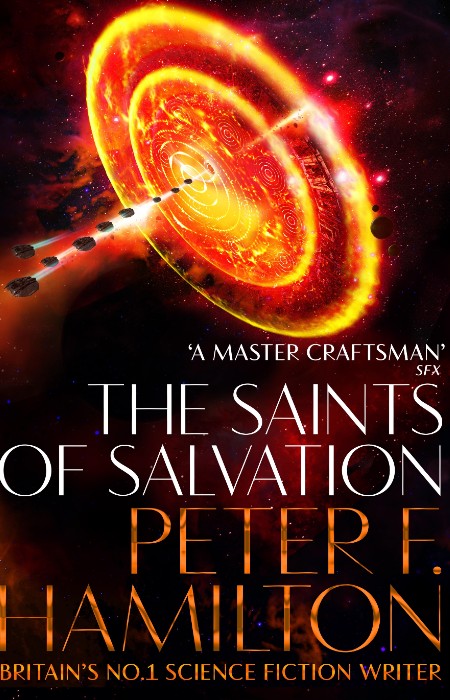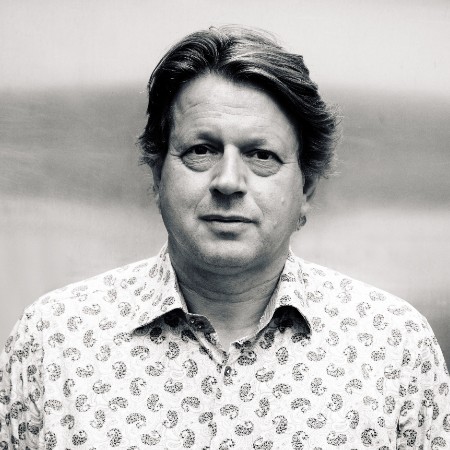
However long you have been waiting for a thrilling and exciting finish to a series of some kind, no matter the medium, there is something inordinately exciting about coming to the end of a story upon which rides the fate of a particular group of people.
Above all else, you want a satisfying conclusion to the story, not least because you have invested a great deal of time and effort in various characters and want them to come to a place where they are supremely successful or happy, or if it’s not that kind of story, then not overly damaged or forever lost to whatever eventually claims them.
There is a lot riding on the end to any series then, especially ones as weighty as epic space operas of the highest order, and in that respect Peter F. Hamilton doesn’t come close to disappointing to The Saints of Salvation, the finish to his suitably massive “The Salvation Sequence”.
A trilogy with a story as big and as expansive as its word count – each novel is approximately 500 pages long which might suggest a successful writer allowed to write what wants unchallenged, uninterrupted and unedited but Hamilton uses every page to judiciously-exercised brilliant effect – “The Salvation Sequence” tells the compellingly immersive of humanity, in two pivotal points in time, as it battles to literally hang onto its soul as onetime benign alien visitors, the Olyix, turn out to have a far more nefarious and religiously crazed agenda than anyone might have guessed.
Promising eternal health, happiness and peace, the usual grab bag of utopian goodies which humanity, well most of it anyway, unquestioningly accepts, the Olyix turn out to be religious nutters of the worst kind (are they are any good kinds?) who are intent on kidnapping every last person on Earth and on its string of settled worlds, reached by the artificial wormhole portals which have become one of Hamilton’s trademarks, and taking them to their God at the End of Time.
“What they’d witnessed left him depressed, yes, but it was the guilt that inflamed his anger and determination. The Olyix have killed Earth, and I helped them. I didn’t mean to. I didn’t know. But that made no difference to the shame.” (P. 12)
There is strong, sickening evidence that humanity is not the first species to suffer this fate, and as the cities of Earth shelter under huge energy shields – forget those outside the major urban centres; they are long lost to the cause, sadly – and start falling one by one, it looks like humanity cannot do much to avoid its fate.
But, of course, these are the same people who can travel through wormholes to other planets, which they then terraform, and you know that enough of them are not going to take this lying down.
If there is a choice between staying free and having your consciousness trapped inside a cocooned bundle, there’s no guessing what most people will choose.
But choosing to fight and actually winning against a fanatical enemy as driven and unyielding as the Olyix are two entirely entirely different things, and as The Saints of Salvation opens (the title refers to five key characters who take the fight to the alien enemy in the most daring of ways), humanity, both in the novel’s present and its far-flung future some thousands of years distant, is as beleaguered as they come.
The Olyix seem to have an answer for evert tactic, and hope begins to dwindle as the initial determination and optimism of the fightback begins to seem like a quixotic battle from which no victory can be claimed.

The Saints of Salvation may then seem like a bleak prospect as trilogy ending novels go, but fear not, this is humanity we’re talking about, and while Hamilton rarely goes easy on his characters, he is not one to abandon hope when there is even a sliver of it in existence.
Giving away too much of the storyline is dangerous given how fulsome and intricately interwoven it is, but suffice to say that as The Saints of Salvation goes on its enrapturing way, readers are treated to the author’s gifted ability for bringing seemingly unconnected narrative threads and making part of a wholly cohesive whole.
As the saints of the title journey some forty-thousand light years to the Olyix’s hidden enclave to position themselves to send a signal about the hideaway’s location to future, hopefully more technologically advanced, weapons-rich humanity, we also spend a considerable amount of highly-rewarding time with these thousands of year hence people, getting to know as well as those who begin the fight in the twenty-third century.
There are no surplus to requirements characters or plot threads in this finale story which, while it is as dense with ideas and technological possibilities as any Hamilton novel, never loses the beating heart of humanity which has sat at the centre of the trilogy’s story since the beginning.
“‘It thinks this is a success?’ Alik asked. ‘It got its ass kicked on S-Day.’
‘Depends on perspective,’ Callum said. ‘Earth is uninhabitable now. There’ll be tens of millions evacuated, which is basically a token when you consider the global population is still probably around the six billion mark. That means the next wave of Olyix will scoop up everyone left. They won, the bastards. This round. Because us being here is a success, as well, isn’t it?’
‘Je-zus, you are getting fucking bleak, man.'” (P. 265)
Hamilton might fill his novels with a tremendous amount of detail, sometimes to the point where your mind is swimming with the sheer enormity of them, but he also peoples them with characters so rich and vividly-realised that you feel like you know them, all of them (quite a feat in a series this big) intimately and well, and plot twists so satisfying that there is never any sense that you are caught in some kind of over-important, top-heavy mess.
That is the last thing you could accuse novels like The Saints of Salvation of being, a conclusion to a masterfully told story that doesn’t just tie of all the loose ends, but which continues to break new and exciting ground it as it does so.
So, it is that even as humanity battles on to one last climactic battle, all kinds of revelations and epiphanies emerge, some of them happily lending themselves to future trilogy arcs of which there will be undoubtedly some, but their very existence pointing to the fact that while The Saints of Salvation may be charged with rapid this epic trilogy up in deeply satisfying fashion, it is far from being simply a lacklustre final entry.
Rather, what we are treated to is a brilliantly-told final instalment that finishes things up in ways that will have you thrilled to the core, on the edge of your seat with excitement and gasping with delight and terror, and which keeps the faith with its startlingly good premise right to the very end, where gods may possibly await but where we certainly know a damn good finish resides, the kind for which Hamilton is renowned and which makes reading any of his trilogies one of those rare treat for which (uncocooned) life exists.